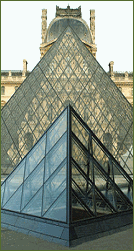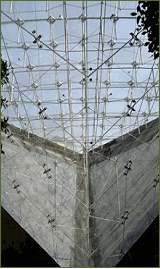|
The Louvre was built on the Western edge of Paris along the River Seine
and the original fortress was changed considerably by King Francis I, then later
transformed again by King Louis XIV and added to by King Louis XV, which is The Louvre as
we know it today.
But with the completion of the Chateau de Versailles
it made The Louvre redundant until it was turned into a museum, where it gradually grew to
engulf a good part of the building rather than just utilising certain sections of
it. King Charles X opened more exhibitions to the public.
In 1888 after excavations led by Marcel Dieulafoy, a French archaeologist, they put the
artefacts on display in newly done rooms in the museum.
Although there was already some Islamic art in the Musee du Louvre this was added to by
donations from Baroness Delort de Gleon and a single display was opened in 1922.
There was an ambitious plan to extend and improve the exhibitions which was launched in
1926 and carried on until after World War II. The Cour du Sphinx was given a glazed
roof, new rooms were opened and others completely refurbished, while some exhibitions were
moved to other museums in the city of Paris.
In the 1960's a restoration area and workshops were set up on the upper floors of the
Musee du Louvre, but the need for better displays and more space was still an issue.
So, in 1981, President Francois Mitterand decided to completely revamp The Louvre and the
Finance Ministry was transferred to different premises to allow for even more space.
Commissioned by President Francois Mitterand, the incredible glass pyramid that was built
by the architect I M Pei, caused a stir initially, but was inaugurated in March 1989 and
serves as the focal point of the main axis and as an entrance to The Louvre museum.
It is from this point that tourists can access different temporary displays, the history
of this world famous museum, along with the bookshop, Le Cafe Marly restaurant, etc.
And apart from some very famous paintings like the Mona Lisa, there are some very
impressive collections, which include Egyptian, Roman and Greek artefacts, but also,
sculptures, and other works of art dating back to the Middle Ages, right through to around
1850.
All museums in Paris are free to enter on the first
Sunday of every month. However, if you are thinking about visiting such a
world-renowned museum like the Musee du Louvre on this day, then expect even greater
queues than normal and many masterpieces hard to get to see because of the crowds!
Many people say that you need at least a day, or even more at The Louvre, yet when you
need a well earned rest or need to refuel your body, then there is an enormous different
choice of food on offer in the cafeterias and restaurants.
Plus whilst in this area you will be able to experience the souvenir shops where you can
purchase anything from postcards, ornaments and posters, and reproductions of famous
paintings not housed at The Louvre. There are also bookshops that have vast
selections of information from artists and sculptures to their works and on other
important artefacts, paintings etc that are housed in other museums throughout the city of
Paris.
Although most of the information boards are in French, there are audio guides that are in
a lot of different languages, which you can hire and there are some exhibits that do have
different languages attached to them, but not all. Or if you plan it in advance, you
can have a guided tour that lasts about 2 hours and takes you round the most well known
exhibits, leaving you free to explore the rest of this museum.
It is also worthwhile getting a map of the place, as it is so vast you could end up
missing exhibits you specifically wanted to see.
But The Louvre definitely lives up to its
reputation as 'the' museum to visit whilst in Paris and there is always something of
interest for everyone, even for the children and once you have been there we are sure you
will want to return again.
Address & Contact Details:
Mus?e du Louvre
Cour Napol?on
Place du Carrousel
75001 Paris
Telephone: 1 40 20 53 17
|
|



